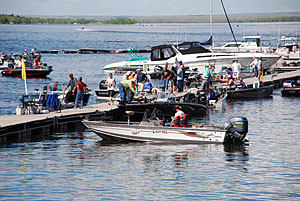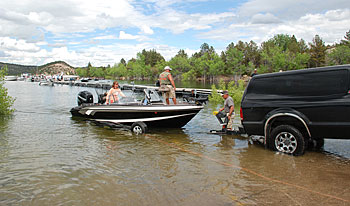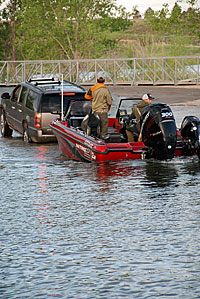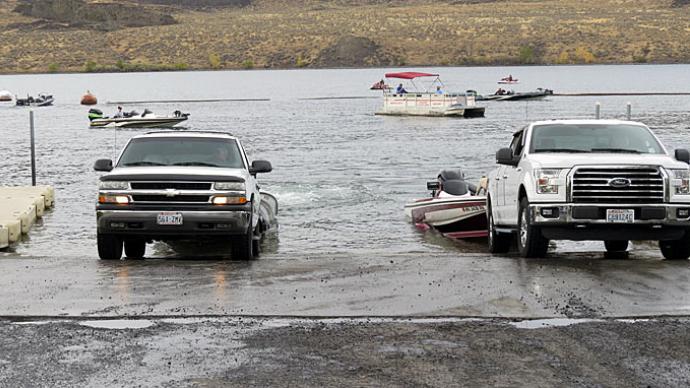
We've all been there. You're readying your boat in the staging area for a fun day of fishing when a hulking 30–foot pontoon boat being pulled by a rusty Chevy Suburban comes rumbling into the parking lot and begins backing into the boat ramp. The driver, obviously the clan patriarch, stops the boat just short of the water and slams the vehicle in park. Doors fly open, and a bevy of urchins pile out, including the family dog.
The tribe clusters in a confused crowd before forming an impromptu chorus line leading from the vehicle to the boat to unload the mountain of gear in the vehicle. Lawn chairs, coolers, fishing rods, power blasters, radio, picnic baskets, snorkels, facemasks, water boards, life jackets, and Fido are all tossed unceremoniously into the boat as the pile in the corroded Suburban quickly dwindles.
Finally, dad backs the boat in as multiple volunteers hold the lines. Having forgotten to unhook the bow hook, someone is elected to wade in and unhook the vessel from the trailer. Once launched, they clumsily tie off the boat for and aft in the middle of the dock. After dad returns from parking the vehicle, he fires up the motor in a cloud of blue smoke, and just as they're about to pull away from the dock, mom decides a potty break is in order – just in case. The whole ensemble unloads again and proceeds single file to the bathrooms, where they return again in single file 15 minutes later. All the time, you’re waiting.
Scenes like that described above are all too familiar at boat ramps. Some individuals have no more courtesy, knowledge, and common sense at the boat ramps than they do on the highway. Boat ramps can become a nightmare, especially on weekends, when infrequent, discourteous boaters take to the water. Few know the rules when it comes to launching a boat. Life would be a lot simpler if they did.
Most of the boat launch and ramp rules are not written in stone. They’re just common sense. One of the first rules is to use the staging area when preparing your boat. Staging areas are located as you enter the parking lot to not interfere with other boats there readying to launch. The staging area is ideal for checking your trailer coupler, unplugging lights, raising the lower unit, checking that the drain plug is in, and run the blower if your boat is equipped with one. This is the place to remove the tie-downs, add bumpers and load the gear you'll need for a day on the water. The boat ramp is not the place to do this when you're on it! Then and only then should you consider backing the trailer into the ramp.

At some launches, there are launching and loading ramps. Make a note of the difference. Backing a boat trailer requires a little practice and experience. Your first trip to the boat ramp is not where to begin learning. Take the vessel and towing vehicle to a large, wide-open parking lot and practice backing the boat. It will be time well spent and make things go much smoother at the ramp.
Make a wide swing into the launch area, decide which ramp is open, and pull up far enough ahead to see the ramp straight behind you in the mirrors. Back SLOWLY towards the ramp. Back the trailer into the water until the vessel is floating and there is sufficient water depth to lower the drive unit. Having someone directing you at the side of the vehicle so you can see them in the mirror can be a great help for inexperienced boaters.
Once in the water, unhook the winch cable and secure a bowline to tie off to the dock. Continue backing the trailer in until the boat floats off the trailer. This process works best if someone is already in the boat and can start the motor and pull the boat over to a courtesy dock or waiting area, so it’s out of the way. The person in the tow vehicle can quickly move away from the ramp to a designated parking area. DO NOT block the ramp with an unattended vessel or vehicle. That should be common sense.

Be careful. Boat ramps can become slippery from water on boats being launched or retrieved and can even become iced up late in the season. During the summer months, algae can grow on the ramp, making them slipperier than goose doo on a sidewalk. Always put the vehicle in park and use the parking brake once you have the boat in the water to prevent the whole rig from sliding into the drink and getting your picture on Facebook. Check the ramp before you back in.
One thing that can make the boat launching/loading process go much smoother is to help individuals that may be having problems. Help guide someone who may be having trouble or offer to pull up the towing vehicle for someone fishing by themselves. The quicker they get in the water, the quicker you can launch your boat.
The loading process can be equally as simple if a few common-sense rules are followed. Ease up to the dock and let someone off that can retrieve the towing vehicle and trailer, and then back away from the dock until they have the trailer backed into the water. Priority for loading is where the towing vehicle and trailer are not where your boat is. Do not pull your boat into the ramp until the towing vehicle is at the ramp. Back the trailer in, so the bunks or rollers are 2/3 submerged. Drive the vessel onto the trailer far enough to attach the winch hook to the bow eye. Use the winch to finish pulling the boat up to the bow rest.
Avoid power loading when possible. Doing so makes a huge hole at the end of the ramp that trailers can fall into and make loading difficult. Secure the safety chain, raise the lower unit and quickly move the towing vehicle and boat off the ramp and out of the way. Once in the staging area, you can secure tie-downs and begin moving gear from the boat to your vehicle.
With the preponderance of invasive species common today, this is also the time to pull the drain plug and make sure all live wells, holds, and the bilge are drained. Look for weeds and vegetation on the trailer and boat that could be transferred to other waters.
Launching and retrieving your boat can be an easy and orderly process if everyone uses some common sense and realizes it’s not all about you.




